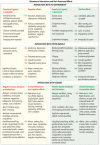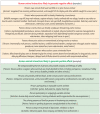The 2020 Five Domains Model: Including Human-Animal Interactions in Assessments of Animal Welfare
- PMID: 33066335
- PMCID: PMC7602120
- DOI: 10.3390/ani10101870
The 2020 Five Domains Model: Including Human-Animal Interactions in Assessments of Animal Welfare
Abstract
Throughout its 25-year history, the Five Domains Model for animal welfare assessment has been regularly updated to include at each stage the latest authenticated developments in animal welfare science thinking. The domains of the most up-to-date Model described here are: 1 Nutrition, 2 Physical Environment, 3 Health, 4 Behavioural Interactions and 5 Mental State. The first four domains focus attention on factors that give rise to specific negative or positive subjective experiences (affects), which contribute to the animal's mental state, as evaluated in Domain 5. More specifically, the first three domains focus mainly on factors that disturb or disrupt particular features of the body's internal stability. Each disturbed or disrupted feature generates sensory inputs which are processed by the brain to form specific negative affects, and these affects are associated with behaviours that act to restore the body's internal stability. As each such behaviour is essential for the survival of the animal, the affects associated with them are collectively referred to as "survival-critical affects". In contrast, Domain 4, now named Behavioural Interactions, focusses on evidence of animals consciously seeking specific goals when interacting behaviourally with (1) the environment, (2) other non-human animals and (3) as a new feature of the Model outlined here, humans. The associated affects, evaluated via Domain 5, are mainly generated by brain processing of sensory inputs elicited by external stimuli. The success of the animals' behavioural attempts to achieve their chosen goals is reflected in whether the associated affects are negative or positive. Collectively referred to as "situation-related affects", these outcomes are understood to contribute to animals' perceptions of their external circumstances. These observations reveal a key distinction between the way survival-critical and situation-related affects influence animals' aligned behaviours. The former mainly reflect compelling motivations to engage in genetically embedded behavioural responses, whereas the latter mainly involve conscious behavioural choices which are the hallmarks of agency. Finally, numerous examples of human-animal interactions and their attendant affects are described, and the qualitative grading of interactions that generate negative or positive affect is also illustrated.
Keywords: affective state; behavioural interactions; biological functioning; environment; human behaviour; humans; other animals; welfare grading; welfare impacts.
Conflict of interest statement
The authors declare no conflict of interest.
Figures








References
-
- Mellor D.J., Reid C.S.W. Concepts of animal well-being and predicting the impact of procedures on experimental animals. In: Baker R.M., Jenkin G., Mellor D.J., editors. Improving the Well-being of Animals in the Research Environment. Australian and New Zealand Council for the Care of Animals in Research and Teaching; Glen Osmond, Australia: 1994. [(accessed on 28 September 2020)]. pp. 3–18. Available online: https://org.uib.no/dyreavd/harm-benefit/Concepts%20of%20animal%20well-be....
-
- Mellor D.J., Stafford K.J. Integrating practical, regulatory and ethical strategies for enhancing farm animal welfare. Aust. Vet. J. 2001;79:762–768. - PubMed
-
- Mellor D.J., Patterson-Kane E., Stafford K.J. The Sciences of Animal Welfare. Wiley-Blackwell Publishing; Oxford, UK: 2009. Animal welfare, grading compromise and mitigating suffering; pp. 72–94.
-
- Mellor D.J. Affective states and the assessment of laboratory-induced animal welfare impacts. ALTEX Proc. 2012;1:445–449.
Publication types
LinkOut - more resources
Full Text Sources
Research Materials

